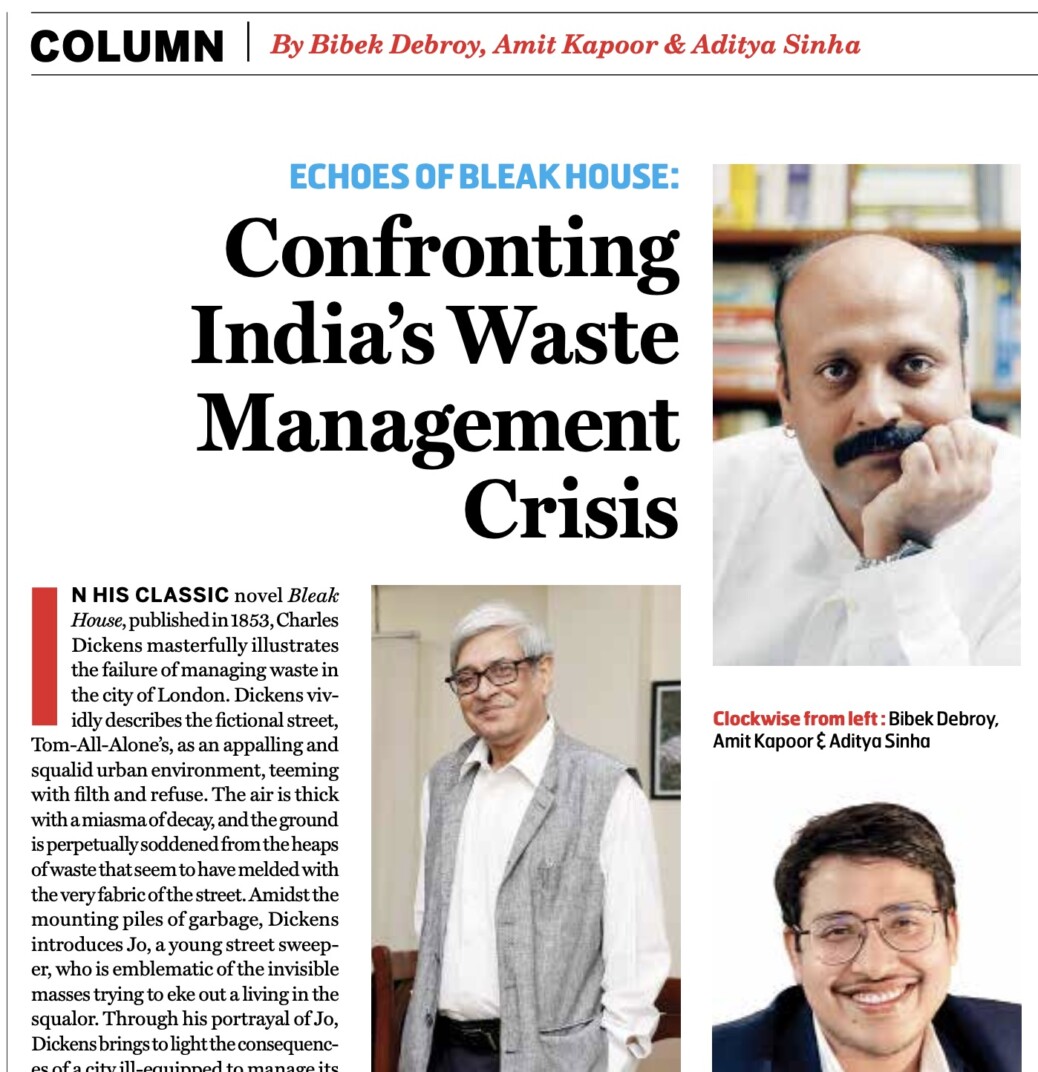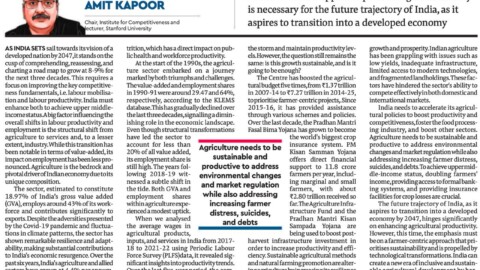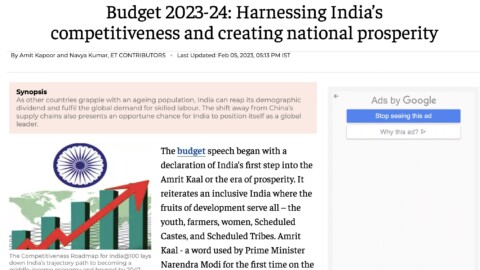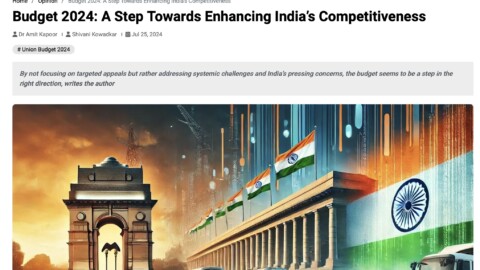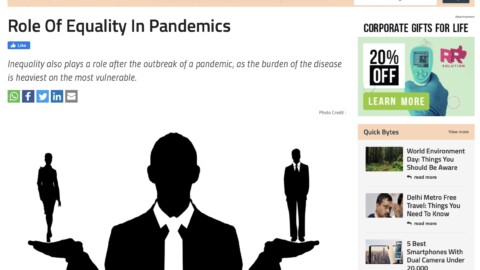Bibek Debroy, Amit Kapoor and Aditya Sinha
In Charles Dickens’ classic novel “Bleak House,” published in 1853, he masterfully illustrates the failure of managing waste in the city of London. Dickens vividly describes the fictional street, Tom-All-Alone’s, as an appalling and squalid urban environment, teeming with filth and refuse. The air is thick with a miasma of decay, and the ground is perpetually soddened from the heaps of waste that seem to have melded with the very fabric of the street. Amidst the mounting piles of garbage, Dickens introduces Jo, a young street sweeper, who is emblematic of the invisible masses trying to eke out a living in the squalor. Through his portrayal of Jo, Dickens brings to light the consequences of a city ill-equipped to manage its waste, and the inevitable human cost of this negligence. The poignant account of Jo and Tom-All-Alone’s serves as a powerful reminder of the urgent need for effective urban solid waste management, a problem that continues to plague cities in India and beyond, even in our modern era.
The precarious state of landfills and open dumping sites in Indian cities harkens back to the dismal conditions of London during the era depicted in “Bleak House.” Metropolitan areas such as Delhi and Mumbai face particularly dire circumstances, generating vast amounts of waste daily while grappling with a scarcity of suitable dumping grounds. For example, the Deonar landfill in Mumbai, established in 1927, is both the oldest and largest landfill in India. Receiving 9,000 metric tonnes of waste each day, it teeters on the brink of collapse. Likewise, the Bhalswa landfill in Delhi, in operation since 1994, is overburdened with decaying waste, having long exceeded its intended carrying capacity.
Landfills and open dumping sites in and around Indian cities present a significant challenge for urban planning and environmental sustainability. Rapid urbanization and population growth have led to an increase in municipal solid waste, causing landfills to overflow and open dumping sites to proliferate. These waste disposal methods not only exacerbate land and water pollution, but also pose serious health risks to local communities. Leachate from landfills can contaminate groundwater, while open dumping contributes to the spread of disease vectors. Furthermore, it generates hazardous greenhouse gases like methane, which contribute to climate change. These issues highlight the pressing need for more sustainable waste management solutions in India, such as recycling, composting, and the implementation of modern waste-to-energy technologies, to reduce reliance on landfills and open dumping and ensure a cleaner, healthier environment for urban residents.
The proliferation of landfills and dumping grounds in Indian cities has led to a significant environmental and health crisis. A contributing factor to the emergence of landfills is the lack of waste segregation, which subsequently complicates recycling processes and ultimately results in the waste being relegated to landfills. Historically, waste segregation has been addressed through two markedly distinct methodologies: (1) Source/Primary Segregation, which entails separating waste at its origin by individuals, households, and institutions, with the implementation of discrete collection systems; and (2) Secondary Segregation, involving mechanical processing and sorting of commingled waste at centralized facilities handling vast amounts of refuse. The initial approach, primary segregation, offers notable benefits, including optimized municipal resource utilization, efficient infrastructure operations, and improved environmental outcomes. By reducing the need for capital, energy, and land-intensive secondary segregation, source-segregated waste is less likely to be contaminated, more easily recycled, and less costly to treat. In countries like India, where wet waste constitutes a significant portion of municipal solid waste, source segregation and recycling can substantially reduce transportation costs and landfill demands, extending the lifespan of existing landfills and alleviating land conflicts.
In developing countries, including India, a pervasive behavioral issue related to waste management is the general public’s reluctance or failure to segregate waste. This attitude can be attributed to a combination of factors, including inadequate awareness of the environmental consequences, lack of infrastructure, and the absence of robust waste management policies. The prevailing culture of disposing mixed waste indiscriminately exacerbates the problem, undermining the potential for effective recycling and composting efforts. Consequently, this ingrained behavior not only perpetuates the expansion of landfills and associated environmental and health hazards but also impedes the progress towards sustainable waste management practices, which are crucial for the nation’s long-term ecological and public health wellbeing.
NITI Aayog has come up with Policy Guidelines Promoting Behaviour Change for Strengthening Waste Segregation at Source. States should keep these guidelines in mind while nudging the residents of urban agglomerations for segregating waste at source. However, there are issues with secondary segregation too. In their column “Segregation of Waste,” Isher Judge Ahluwalia and Ayush Khare discuss the negative consequences of waste management practices that discourage waste segregation (https://bit.ly/2mxfq3L). Two primary factors contributing to this problem are the use of waste transport contracts based on tonnage and the rising adoption of compactors in waste management systems. Tonnage-based contracts incentivize private contractors to maximize waste weight by mixing wet and dry waste, while compactors, by their very nature, compress waste and make segregation nearly impossible. Compacted waste not only hinders resource recovery but also leads to environmental issues such as leachate production, groundwater contamination, and methane generation. The latter contributes to global warming and, when combined with waste pickers’ fire-starting practices, can exacerbate landfill fires and release toxic substances like dioxins and furans. Overall, the current waste management practices undermine segregation efforts and have harmful implications for the environment and public health.
The Swacch Bharat Mission-Urban 2.0 (SMB-U 2.0) has a dashboard of landfills in India. India had 2,439 legacy dumpsites (Primarily dumpsites having legacy waste >= 1000 Tonne) in the country spread in an area of 18,585 acres. SBM-U 2.0 is currently being implemented, with the overarching objective of attaining a “garbage-free” status for every urban center in the nation. This ambitious initiative encompasses, among other components, the comprehensive remediation of all extant landfills and legacy dumpsites by the year 2026, for which the central government is providing financial support.
However, in India, the current status of dumpsites presents a concerning situation. With a total of 2,243 dumpsites, primarily consisting of legacy waste exceeding 1,000 tonnes, the scale of the issue is significant. The accumulated legacy waste amounts to 2,439 tonnes, of which only 704 tonnes (29%) have been remediated. This leaves 1,735 tonnes (71%) of waste still requiring remediation.
Moreover, the total area occupied by these dumpsites spans 18,588.85 square units. Despite efforts to reclaim this land, only 2,871.37 square units (15%) have been successfully reclaimed, leaving a staggering 15,717 square units (85%) awaiting reclamation.

The states which have been most successful in remediating the dumpsites in absolute terms are Tamil Nadu (619.59 acres), Maharashtra (440.04), Telangana (416.00) Uttar Pradesh (459.24), Madhya Pradesh (278.75). The top five states in terms of reclaimed dumpsite area percentage are: Chhattisgarh (59.3%, 50.20/84.71 acres); Telangana (35.6%, 416.00/1,166.57 acres); Madhya Pradesh (32.5%, 278.75/857.23 acres); Tamil Nadu (28.5%, 619.59/2,173.19 acres) and Bihar (26.0%, 63.30/242.98 acres);. India continues to face a substantial challenge in addressing and remediating the vast amounts of waste present at the country’s numerous dumpsites.
As we reflect on the haunting depiction of waste management failure in Dickens’ “Bleak House,” it is apparent that the challenges and consequences of inadequate waste management persist today, particularly in Indian cities. With majority of the legacy dumpsites still in need of remediation and a culture of improper waste segregation, India faces an uphill battle in achieving a sustainable and healthy urban environment. By confronting the behavioral, infrastructural, and policy obstacles hindering effective waste segregation and pursuing eco-friendly alternatives to landfills and open dumping, the nation can triumphantly reclaim its land and ensure the health and well-being of its city dwellers. In doing so, the somber Dickensian panorama can be transformed into a vibrant, flourishing future characterized by sustainability and prosperity. In our upcoming column, we will delve into various approaches and tactics for effective solid waste management in India.
The article was published with Business World on May 15, 2023.
